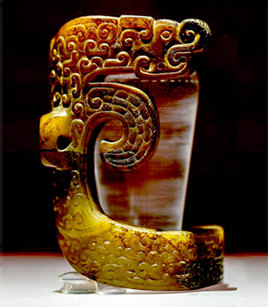Marquis of Haihun cemetery

A jade ornament unearthed from the Marquis of Haihun cemetery Photo: CFP
Liu He (?–59 BCE) was an emperor of the Western Han Dynasty (206 BCE–8 CE). He became emperor in 74 BCE, but was deposed only 27 days later, and omitted from the official list of emperors. After being demoted to the rank of marquis, Liu was given the new fief of Haihun in modern Jiangxi Province and became known as the Marquis of Haihun.
The mausoleum of the Marquis of Haihun is one of the few Western Han imperial mausoleums that have not been looted. It contains nine tombs and a chariot burial site, covering an area of roughly 40,000 square meters. Archaeological activities at the cemetery started in 2011. More than 10,000 cultural relics, including bronze and jade artifacts, bamboo slips, over 10 tons of coins, and 115 kg of gold artifacts, have been unearthed so far.
Archaeologists found a jade seal bearing the name “Liu He” in the main coffin, which proved the tomb owner’s identity. A dressing mirror with the earliest portrait of Confucius ever discovered has attracted lots of attention. A bronze pot containing chestnuts was unearthed at the Marquis of Haihun cemetery, which may be evidence of the popularity of hot pot cuisine among ancient aristocrats. Experts also unearthed two 2,000-year-old bronze lamps from the cemetery. The lamps are both in the shape of a goose catching a fish in its mouth. The candle is attached to the fish. Smoke emitted during the burning of wax can enter the goose’s body via an opening on the fish, travel through the goose’s neck and be dissolved by water stored in its hollow belly. The lamps can be dismantled for cleaning and have swinging lamp shades to adjust brightness.
Edited by REN GUANHONG
